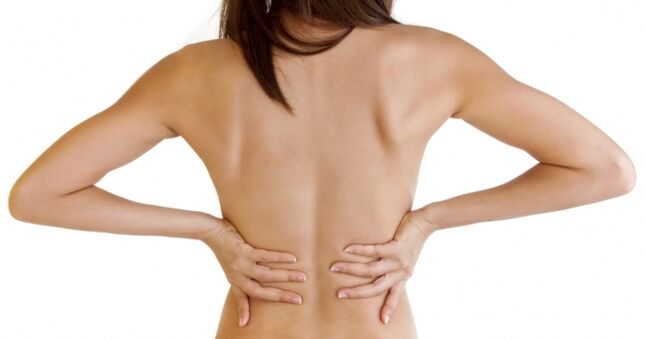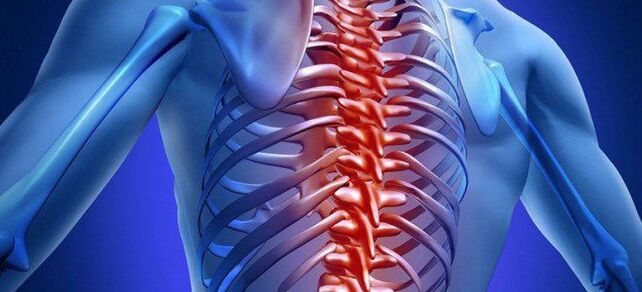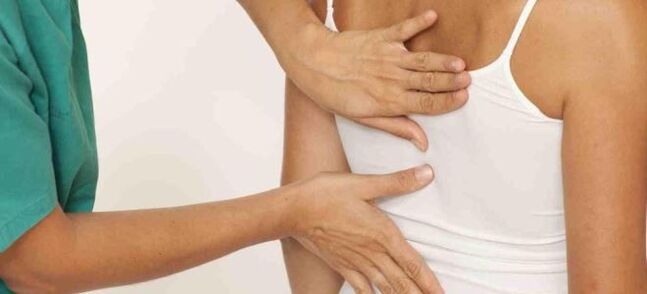
Recently, doctors are increasingly receiving complaints about back pain, and young women often suffer from this disease. If the discomfort is localized in the thoracic spine, then the cause may be a pathology such as thoracic osteochondrosis, the symptoms of which are described in detail below.
Osteoarthritis of the chest - causes
Spondylosis is a disease in which negative changes occur in the tissues of the intervertebral disc - the component of the spine located between two vertebral bodies. The intervertebral disc is a flat, circular cushion composed of a gel-like collagen core, fibrous connective tissue, and vitreous cartilage. The main functions provided by these structures are:
- connects and maintains adjacent vertebral bodies;
- shock protection for the spine, protection from injuries caused by gravity and body loads;
- Ensures the mobility of adjacent vertebrae together.
If the intervertebral discs are in satisfactory functional condition, the spine will have elasticity, mobility and the ability to withstand various mechanical loads. When the cartilage structure changes shape, texture, and loses strength and elasticity, these functions cannot be fully performed. Essentially, this occurs in the context of metabolic disorders.

In part, the pathological changes in the intervertebral discs that cause degeneration of the thoracic cartilage are explained by the fact that with age, nutrition through their own blood vessels stops and the supply of nutrients can only be carried out. thanks to neighboring structures (ligaments, vertebral bodies). The exact causes of poor nutritional status of the intervertebral structures and the mechanisms of their destruction are unknown, but doctors identify several influencing factors:
- systemic metabolic disorders in the body;
- excessive body weight;
- poor nutrition and water intake;
- inactive;
- sedentary work;
- bad posture;
- flat feet;
- back and spine injuries;
- physical labor or intense sports practice;
- pregnancy;
- Wear uncomfortable shoes, high heels.
Degrees of bone and cartilage degeneration in the chest area
A disease such as thoracic osteochondrosis does not manifest symptoms immediately, because it develops gradually and over a long period of time. In addition, because the mobility of the spine in this area is low, osteochondrosis in the thoracic region manifests itself in later stages, when there are significant pathological changes. In total, four degrees of pathology are distinguished, depending on the developmental deviation.
Grade 1 osteochondrosis of the chest
The preclinical stage is grade 1 cartilage degeneration in the thoracic spine. At this stage, partial dehydration occurs and compaction of the central part of the intervertebral discs occurs, their height decreases, which leads to a decrease in their elasticity and firmness. The spine's ability to withstand normal loads is preserved. The disc begins to form.
Grade 2 osteochondrosis of the chest
When grade 2 osteochondrosis develops, the disease is characterized by the appearance of cracks in the annulus fibrosus. The process of subsidence (thinning) of the discs continues, the amount of fluid between the vertebrae is significantly reduced and the vertebrae begin to rub against each other as the load on the back increases. This stage is sometimes called disc radiculitis.

Grade 3 osteochondrosis of the chest
Grade 3 thoracic spondylosis is accompanied by destruction and rupture of the fibrous tissue of the intervertebral disc, releasing the core, i. e. protrusion and herniation of the intervertebral disc occurs. As a result, nerve roots begin to be compressed, nearby blood vessels are compressed, and veins and arteries are also compressed.
Osteochondrosis of the chest 4 degrees
The final, most serious stage of the disease is characterized by displacement, twisting, deformation of the vertebral body, increased area and proliferation. The affected fibrous disc tissue begins to be replaced by bone tissue in the form of specific growths - bone spurs, compressing the spinal cord. As a result, the mobility of the spine is significantly reduced.
Osteonecrosis of the thoracic spine - symptoms
Due to the peculiarities of the localization of pathological processes, osteoarthritis in the chest area has both typical and atypical symptoms, repeating the manifestations of other diseases. This is because blood vessels and nerve fibers are compressed, changing the structure of the spine and disrupting the function of nearby internal organs.
Let us list those symptoms of thoracic osteoarthritis that are the most characteristic and common:
- pain in the back and chest;
- feeling of pressure in the chest;
- tingling sensation in limbs;
- numbness in arms, legs, neck, shoulders;
- joint stiffness, back and limb pain;
- muscle spasms in the upper and middle back;
- limited mobility of the spine in this area (difficulty bending the body).
Pain due to osteonecrosis of the thoracic spine
When diagnosed with "osteonecrosis of the chest", pain-related symptoms appear along with other symptoms. Their intensity and duration depend on the stage of the pathological process. The location of the pain may periodically change rapidly, such as moving from one area of the chest to another, covering the entire chest. Pain is often felt in the area between the shoulder blades. The nature of pain in thoracic osteoarthritis is dull, compressed, and sharp. The pain increases at night and when:
- raise your hand;
- neck turn;
- carrying heavy objects;
- sudden movements;
- increase physical activity;
- heavy breathing, coughing, sneezing;
- Hypothermia.
Can you have difficulty breathing when you have thoracic osteoarthritis?
Due to displacement of the vertebral bodies, pathological changes in the structure of the chest, compression of nerve fibers and blood vessels related to the lungs, shortness of breath often occurs with thoracic osteoarthritis. In addition, because in the chest area there are structures responsible for controlling the activity of the heart, intestines, liver, kidneys and a number of other organs, the disease in many cases is accompanied by the following symptoms:
- headache;
- pain in the heart area;
- mammary gland pain;
- pain in the hypogastric area (similar to manifestations of pancreatitis, cholecystitis);
- Epigastric pain not related to eating;
- discomfort in the throat, esophagus, feeling of a foreign body;
- sexual dysfunction.
Heart attack with degeneration of cartilage in the chest area, frequent pressing and squeezing, can cause misunderstanding when diagnosing, because it is similar to the manifestations of angina and myocardial infarction. The characteristics of these feelings are that they last for a long time and have no effect when using drugs that dilate the heart's blood vessels. There were no changes in the electrocardiogram.

Thoracic osteochondrosis syndrome
Symptoms of mammary cartilage degeneration in women, related to a single mechanism of occurrence, are present in many cases in a complex manner. There are two syndromes with a specific set of medical conditions caused by thoracic osteochondrosis:
- back-ache;
- dorsago.
Back pain in the thoracic spine
The pain is long lasting and not obvious when there is thoracic osteoarthritis in women, often characterized by aching and stretching, inherent in back pain. Complaints may appear for 2-3 weeks, with discomfort slightly decreasing (especially when walking) or increasing (often at night, when bending over or breathing deeply). When suffering from this syndrome, thoracic osteochondrosis may also have symptoms related to difficulty breathing and muscle stiffness.
Dorsago of the thoracic spine
Paroxysmal manifestations of the disease are called "back pain" or "thoracic lumbago". In this case, the pain appears suddenly, is severe and often resembles signs of a heart attack. An attack of osteonecrosis of the chest has the following symptoms:
- pain as sharp as a dagger;
- feel pain in the area between the ribs and intercostal area;
- often an attack appears after a long time in one position;
- pain increases when turning the body;
- there is difficulty breathing, severe muscle tension.
Degeneration of the thoracic spine - consequences
If treatment of the pathology is not started in time, osteonecrosis in the chest area can cause the following consequences:
- vegetative-vascular dystonia;
- migraine headache;
- dysfunction of internal organs (liver, kidneys, etc. );
- hearing loss, vision loss;
- epicondylitis of the elbow joint;
- paralysis and numbness of the arm;
- rachiocampsis;
- loss of sensitivity of skin tissue;
- disability, etc. v.

How to treat breast osteonecrosis?
If symptoms of thoracic osteoarthritis appear, a neurologist should be consulted, who after examining the back and examining the spine in several positions of the patient will be able to make the main diagnosis. To determine the extent of damage, X-rays, magnetic resonance imaging or computed tomography are indicated. Treatment tactics depend on the results obtained.
Usually, painful symptoms of thoracic osteoarthritis of the spine are eliminated by taking nonsteroidal anti-inflammatory drugs. In more severe cases, accompanied by severe pain, paravertebral blockade can be performed with anesthetic solutions. Additionally, the following medications may be prescribed as part of conservative therapy:
- muscle relaxants;
- chondroprotector;
- corticosteroids, etc. v.
To improve metabolism, eliminate muscle hypertonia and prevent various complications, the following treatment methods are used:
- physical therapy;
- Massage;
- manual therapy;
- spinal traction;
- physical therapy procedures (laser, ultrasound, etc. ).
Surgical treatment is required if the spinal cord is compressed by a fragment of the disc. In this case, a laminectomy can be performed - resection of the vertebral arch or discectomy - removal of part of the disc or complete removal by fusion. At clinics with modern equipment, surgical procedures are performed using minimally traumatic methods through small incisions.
























